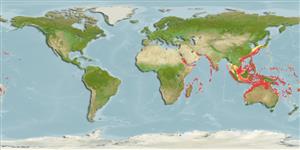Classification / Names
Common names from other countries
Main reference
Size / Weight / Age
Max length : 80.0 cm TL male/unsexed; (Ref. 89707); common length : 50.0 cm TL male/unsexed; (Ref. 5450); max. published weight: 7.0 kg (Ref. 4787); max. reported age: 29 years (Ref. 42001)
Length at first maturity
Lm 28.0, range 23 - 31 cm
Environment
Marine; reef-associated; non-migratory; depth range 4 - 300 m (Ref. 11888)
Climate / Range
Tropical, preferred 28°C (Ref. 107945); 37°N - 34°S, 28°E - 169°W (Ref. 5222)
Distribution
Indo-Pacific: Red Sea to Natal, South Africa and eastward to the western Pacific, north to southern Japan, south to New Caledonia. Records from Persian Gulf are apparently misidentifications of Epinephelus polylepis. Not verified from the Comoros, continental shelf between Oman and Cambodia, Taiwan, Philippines, Indonesia, and Australia.
Countries | FAO areas | Ecosystems | Occurrences | Introductions
Short description
Dorsal
spines
(total): 11;
Dorsal
soft rays
(total): 16-18;
Anal
spines: 3;
Anal
soft rays: 8. Live color whitish, with small dark brown spots on head, body, and fins except ventrally on head, thorax, and lower abdomen. Can assume a transient color phase of 3-4 rows of very large round dark spots on top of the small-spot pattern. 96-125 scales in longitudinal series. Pyloric caeca 26-52 (Ref. 04787); characterized further by having ctenoid body scales, except cycloid scales on nape, thorax, parts of ventral abdomen; body with auxiliary scales; greatest depth of body 2.8-3.3 in SL; truncate to slightly emarginate caudal fin; pelvic fins 1.7-2.4 in head length (Ref. 90102); interorbital slightly convex; preopercle angle rounded, 4-7 enlarged serrae at angle below a slight notch; upper edge of operculum straight; posterior nostril not noticeably larger than anterior nostril; maxilla reaches about to vertical at rear edge of eye; scaly maxilla, low step on posterior part of ventral edge; 2-4 rows of teeth in midlateral part of lower jaw, inner ones about twice the size of outer teeth (Ref. 089707).
IUCN Red List Status (Ref. 115185)
Threat to humans
Harmless
Human uses
Fisheries: commercial
More information
ReferencesAquacultureAquaculture profileStrainsGeneticsAllele frequenciesHeritabilityDiseasesProcessingMass conversion
Tools
Special reports
Download XML
Internet sources
Estimates of some properties based on models
Phylogenetic diversity index
PD50 = 0.5000 many relatives (e.g. carps) 0.5 - 2.0 few relatives (e.g. lungfishes)
Trophic Level
4.0 ±0.67 se; Based on food items.
Resilience
Low, minimum population doubling time 4.5 - 14 years (K=0.17-0.19; tmax=29; tm=2-3; Fec = 1,014,818)
Vulnerability
Moderate vulnerability (38 of 100)
Price category
